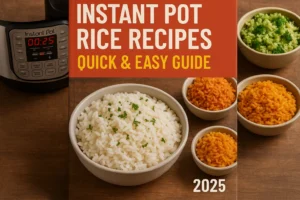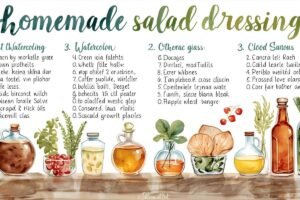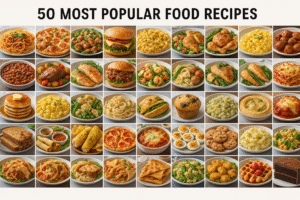A satisfying breakfast doesn’t have to be complicated. With a bit of planning and a few smart staples, you can create high-protein bowls that taste amazing, keep you full, and fit seamlessly into your morning routine. Protein helps with satiety and muscle maintenance, and pairing it with fiber-rich whole grains, fruits, and vegetables creates a balanced, macro-friendly meal that carries you from breakfast to lunch without a crash. Harvard’s Healthy Eating Plate recommends making room for healthy proteins alongside whole grains, fruits and vegetables, and healthy fats—a simple template that works beautifully in a bowl format.
Before you dive into this week’s rotation, it helps to know a few reliable protein anchors. Greek yogurt packs a notable amount of protein per single-serve 170g container (approximately 17g), making it a natural base for sweet or savory bowls. Eggs deliver roughly 6 g of protein each and pair well with grains and veggies. Plant-based options, such as tofu, black beans, edamame, and quinoa, also provide impressive amounts of protein, especially when combined in protein-packed breakfast bowls.
Below you’ll find 11 high-protein breakfast bowls designed for quick prep, meal-prep flexibility, and big, satisfying flavor. Each section explains what to use, why it works, and how to assemble. Swap similar ingredients based on your pantry and dietary needs—these bowls are versatile by design.
What Makes a Great High-Protein Breakfast Bowl
A great high-protein breakfast bowl begins with a protein-dense base and layers on complex carbohydrates for sustained energy. It concludes with fresh produce and healthy fats for essential micronutrients and flavor. If you follow the healthy plate approach, aim for a quarter of the plate to be protein, a quarter to be whole grains, and the rest to be vegetables and fruit, with a drizzle of healthy oils or nuts and seeds. This simple balance makes the bowl nutrient-dense, filling, and blood-sugar-friendly.
For quick reference when building bowls:
A 170g single-serve nonfat Greek yogurt typically provides approximately 17g of protein.
One large egg provides about 6 g of protein.
One cup of cooked quinoa provides approximately 8 grams of protein, along with fiber and essential minerals.
½ cup of cooked black beans adds approximately 7 g of protein and fiber.
Use those anchors to mix and match—and remember that variety also supports long-term health and flavor enjoyment.
How to Build Protein-Packed Bowls That Fit Your Morning
Start with your protein base—Greek yogurt, eggs, cottage cheese, tofu, beans, or edamame—then add your whole-grain layer, such as oats or quinoa. Finish with color and crunch from berries, greens, tomatoes, avocado, or seeds, plus a sauce or seasoning to unify flavors. This approach creates macro-balanced, meal-prep-friendly bowls you can assemble in minutes. The constant? Every bowl below intentionally centers high-quality protein as the star, with supportive carbs and fats for steady energy and satisfaction.
11 High-Protein Breakfast Bowls to Put on Repeat
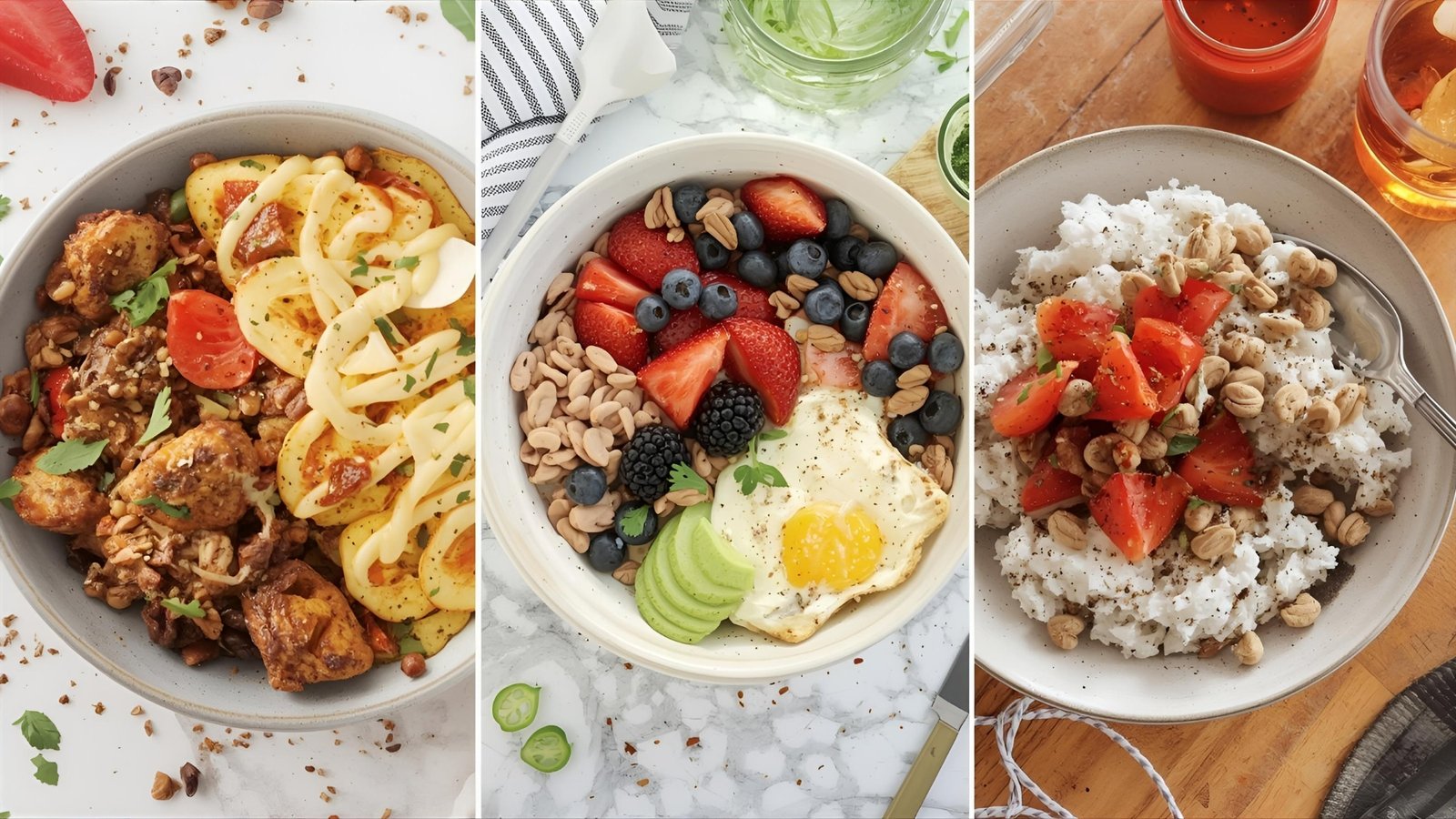
1) Greek Yogurt, Berry & Crunch Bowl
This classic protein bowl begins with a container of nonfat Greek yogurt, providing a generous protein foundation in an instant. Swirl in a spoonful of nut or seed butter for creaminess and staying power, then layer fresh berries and sprinkle chopped nuts for texture. The yogurt’s protein helps with fullness; the berries bring antioxidants and natural sweetness; the nuts add healthy fats for a balanced, protein-forward breakfast that tastes like dessert.
2) Quinoa, Egg & Avocado Sunrise Bowl
Cook a pot of quinoa ahead of time for the week; each morning, reheat a scoop and top with a jammy or fried egg, sliced avocado, a handful of baby spinach, and a squeeze of lemon. Quinoa adds whole-grain fiber and a modest protein boost, while the egg brings high-quality protein and satisfying richness. Finish with a pinch of chili flakes and a drizzle of olive oil for a savory, protein-rich bowl that feels café-worthy but takes minutes.
3) Cottage Cheese Garden Bowl with Cherry Tomatoes & Herbs
Start with creamy, low-fat cottage cheese and tumble in halved cherry tomatoes, diced cucumber, and chopped fresh herbs like dill and chives. Add a spoon of olive oil and cracked pepper. Cottage cheese is naturally high in protein, which, when combined with the water-rich vegetables, creates a light yet satisfying morning bowl. Scoop it over warmed whole-grain toast points or leftover brown rice for extra staying power.
4) Tofu Scramble Bowl with Quinoa and Greens
Crumble the firm tofu and sauté it with turmeric, garlic, and a pinch of cumin until golden. Then, fold in the cooked quinoa and a handful of greens. The tofu offers an easy, plant-based source of complete protein and absorbs whatever flavors you add to it. A spoonful of salsa or tahini sauce over the top ties everything together, turning this protein-packed breakfast bowl into a craveable weekday staple.
5) Smoked Salmon, Egg & Dill Breakfast Bowl
Layer steamed potatoes or warm barley in a bowl, top with flaked smoked salmon, a soft-boiled egg, cucumbers, and dill. A spoon of yogurt-lemon sauce adds tang and a bit more protein. The salmon delivers a concentrated protein punch and savory depth, while the egg and yogurt complement the macro-friendly mix. It’s a high-protein bowl that feels elevated but assembles quickly with pantry staples.
6) Black Bean & Sweet Potato Southwest Bowl
Roast cubed sweet potatoes with paprika and toss them warm with black beans, cherry tomatoes, corn kernels, and chopped cilantro. Add a fried egg on top if you like. The beans provide plant-based protein and fiber, the egg adds additional protein and richness, and the sweet potato offers slow-burning carbs. A dollop of Greek yogurt in place of sour cream adds tang and an extra protein boost.
7) Edamame, Brown Rice & Sesame Ginger Bowl
If you like Asian-inspired flavors in the morning, try a warm bowl of brown rice covered with shelled edamame, shredded carrots, and sliced scallions. Drizzle a simple dressing of soy sauce, rice vinegar, and a hint of ginger. Edamame contributes a meaningful amount of plant-based protein and a mild sweetness that complements the ginger-soy dressing, creating a protein-forward breakfast that’s both meal-prep friendly and satisfying.
8) Peanut Butter, Banana & Chia Oatmeal Bowl
Simmer old-fashioned oats until creamy, then stir in peanut butter for silkiness and protein. Top with sliced banana and a sprinkle of chia seeds for texture and extra nutrients. Oats bring heartiness and soluble fiber; peanut butter adds protein and healthy fats; chia contributes additional fiber and a touch more protein for a protein-packed bowl with a nostalgic flavor profile.
9) Savory Yogurt Bowl with Cucumbers, Olive Oil & Za’atar
For a Middle Eastern spin, spread Greek yogurt in a shallow bowl and top with diced cucumber, cherry tomatoes, a spoonful of chickpeas or lentils, olive oil, and a dusting of za’atar. Scoop with warm pita or spoon over leftover farro. The yogurt forms a cool, high-protein base; the legumes add extra protein and fiber; the herbs and spices make it truly stand out. It’s a high-protein breakfast bowl that’s bright, savory, and immensely satisfying.
10) Veggie-Loaded Egg & Quinoa Hash Bowl
Sauté onions, bell peppers, and zucchini until tender, then fold in a cup of cooked quinoa and a handful of spinach. Push the veggies to the side and scramble two eggs in the same pan, then toss everything together. This is a protein-rich, vegetable-forward bowl that scales well for batch prep and reheats nicely throughout the week. Finish with a few crumbles of feta, if you like, for a tangy flourish.
11) Cottage Cheese “Cheesecake” Bowl with Berries & Nuts
Blend cottage cheese with a dash of vanilla until smooth and silky, then spoon it into a bowl. Top with mixed berries and a handful of chopped almonds or walnuts. The result tastes like cheesecake for breakfast, yet it’s macro-friendly and packed with protein. If you prefer a warmer bowl, spoon this over hot quinoa or oatmeal. Either way, it’s a high-protein option that satisfies a sweet tooth while keeping you full.
Ingredient Swaps and Smart Prep Tips
If you’re lactose-free, swap Greek yogurt or cottage cheese with unsweetened soy yogurt or silken tofu blends. For added staying power, consider adding a scoop of cooked quinoa or steel-cut oats to any bowl. For plant-forward eaters, use edamame, black beans, or tofu as your base and add an egg only if you want it. Building bowls around these staples keeps your breakfast protein-dense while honoring personal preferences and dietary needs. Remember, the overall pattern matters: balance your bowl with whole grains, produce, and healthy fats for a daily routine that supports long-term health.
Are High-Protein Breakfast Bowls Healthy Every Day?
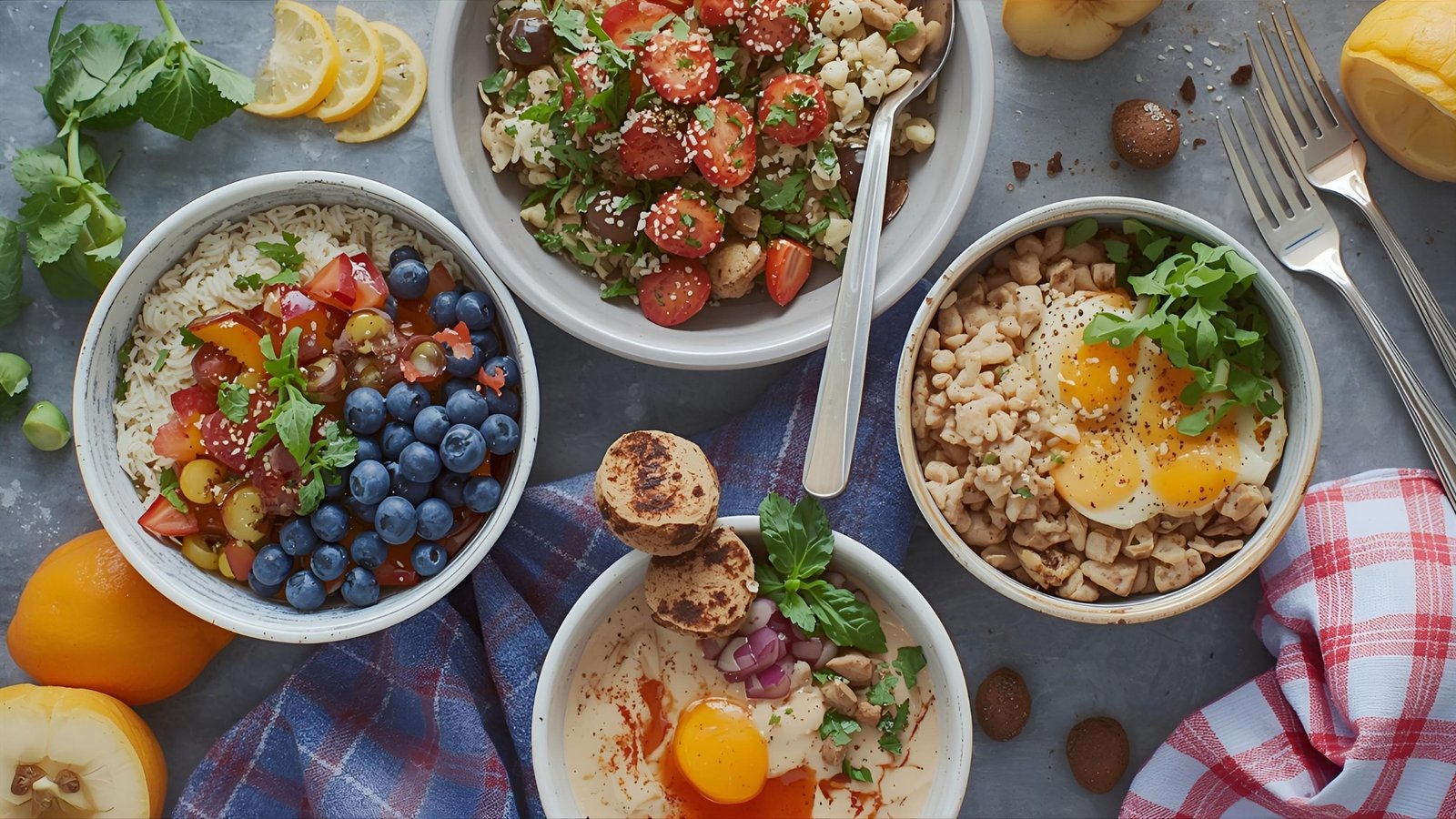
High-protein breakfasts can be a wise choice, but the source of protein matters. Health authorities encourage emphasizing fish, poultry, beans, soy, and nuts more often than red and processed meats. Plant-forward proteins bring fiber and beneficial fats; fish like salmon adds omega-3s. Framing your breakfast bowls around these healthy protein sources helps you stay full while supporting overall wellness.
Portion Guidance You Can Trust
If you enjoy tracking your macros, here are a few estimated values to use when planning meals for the week. A single 170 g container of nonfat Greek yogurt lands around 17 g protein; each large egg adds about 6 g; a cup of cooked quinoa contributes roughly 8 g; and a ½-cup of cooked black beans adds about 7 g. These values help you visualize how quickly a breakfast bowl can reach 20–30 g of protein, a range many people find satisfying in the morning. Adjust portions to your energy needs and preferences.
A 5-Day Sample Breakfast Bowl Plan
Monday: Greek yogurt, berries, and almond crunch.
Tuesday: Quinoa, egg, avocado, and spinach.
Wednesday: Cottage cheese garden bowl with tomatoes and dill.
Thursday: Tofu scramble with quinoa and sautéed greens.
Friday: Peanut butter–banana–chia oatmeal.
Rotate the other bowls on the weekend or swap them in during the week. This cadence keeps your mornings interesting while sticking to the protein-first structure that makes bowl breakfasts so reliable. If you prep a batch of quinoa, chop some vegetables, and keep eggs or tofu on hand, you’ll always have the building blocks for a protein-packed breakfast.
Final Tips for Flavor & Satiety
Lean on fresh herbs, spice blends, citrus, and simple sauces to keep your bowls exciting. A lemon-tahini drizzle, a spoon of salsa, or a sprinkle of za’atar can transform a familiar base. For sweetness without the sugar rush, try ripe fruit or a drizzle of honey over Greek yogurt. For savory lovers, fold in roasted vegetables and a soft-boiled egg. Most of all, embrace flexibility. 11 High-Protein Bowls are a format, not a strict recipe, which means they can evolve with your tastes and schedule. For overall balance, remember the healthy plate snapshot: protein, whole grains, plenty of produce, and a touch of healthy fat.
Conclusion
When mornings are busy, high-protein breakfast bowls are an easy and delicious way to eat well. By centering on quality protein and layering in whole grains, fruit, vegetables, and healthy fats, you create macro-balanced, nutrient-dense meals that keep you energized without fuss. Use the 11 bowls above as a weekly rotation or a creative springboard. With a few pantry staples and a little prep, you’ll have flavorful, protein-packed breakfasts that make every day feel more effortless—and more satisfying.
FAQs
Q: How much protein should a breakfast bowl include?
There’s no perfect number for everyone, but using anchors like one 170 g Greek yogurt (about 17 g protein) plus an egg (about 6 g) or ½ cup of beans (about 7 g) quickly gets many bowls into the 20–30 g range that people often find filling. Adjust based on appetite, activity, and overall daily targets.
Q: Are plant-based high-protein bowls as nutritious as bowls with eggs or dairy?
Absolutely. Building bowls around tofu, edamame, beans, and whole grains provides a balanced combination of quality protein, fiber, and healthy fats. Emphasizing these sources aligns with guidance to favor plant proteins more often.
Q: Can I make these bowls ahead for meal prep?
Yes. Cook quinoa or other grains in bulk, roast vegetables, and pre-portion protein components, such as tofu or beans, for easy meal preparation. Assemble wet ingredients (yogurt, sauces) the morning of to keep textures fresh. Quinoa holds up well in the fridge and reheats quickly without drying out.
Q: What if I don’t eat dairy?
Use soy or almond-based yogurts and rely on tofu, edamame, eggs (if you eat them), and legumes for the protein base. A tahini or nut-butter drizzle adds creaminess and healthy fats while keeping the protein-first approach intact.
Q: Which add-ins boost protein without changing the flavor too much?
A scoop of Greek yogurt stirred into oatmeal, a handful of edamame in a grain bowl, or an extra egg white in a scramble are subtle ways to raise protein without overpowering the bowl. Chopped nuts and seeds also contribute a slight boost while improving texture.
See More: 50 Most Popular Food Recipes Every Home Cook Should Master | Easy Cooking Guide



